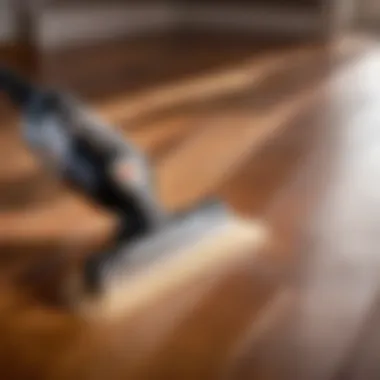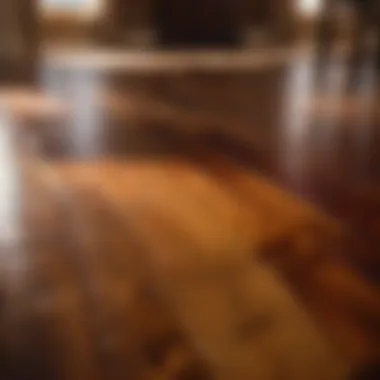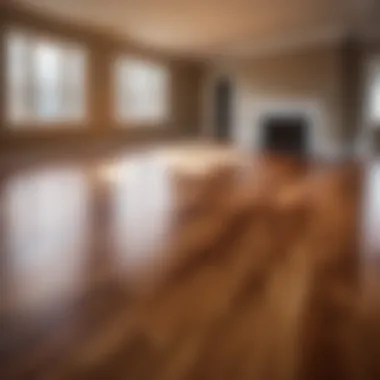A Comprehensive Guide to Sanding, Staining, and Sealing Hardwood Floors for a Pristine Finish


Materials:
To kick off your hardwood floor rejuvenation project, you will need to gather a comprehensive list of materials. Be meticulous in your selections to ensure a smooth and successful process.
-
Sanding Materials:
- Orbital Sander
- Sandpaper (varying grits: 36, 60, 80, 120)
- Vacuum Cleaner
-
Staining Materials:
- Wood Stain (choose a shade that complements your space)
- Brushes or Rags for application
- Protective Gloves
-
Sealing Materials:
- Polyurethane Sealer
- Applicator (brush or lambswool)
- Stir Stick
- Mineral Spirits for cleanup
Detailed Instructions:
-
Sanding:
- Begin by sanding the entire floor with the coarsest grit (36). Work in the direction of the wood grain to remove any existing finish.
- Progressively move to finer grits (60, 80, 120) for a smooth surface.
- Vacuum the floor thoroughly to remove all dust particles.
-
Staining:
- Stir the wood stain well before application.
- Use a brush or rag to apply the stain in the direction of the grain.
- Allow the stain to dry completely as per manufacturer's instructions.
-
Sealing:
- Apply a thin, even coat of polyurethane sealer using an applicator.
- Work on small sections at a time to ensure uniform coverage.
- Allow the sealant to dry according to the recommended drying time.
Technical Aspects:
- Tools: Ensure your sander is in good condition to avoid uneven sanding.
- Timing: Plan your project on days with low humidity for optimal drying times.
- Techniques: Master the art of feathering edges while staining for a seamless finish.
Sequential Steps:


- Preparation: Clear the room of furniture and obstacles to have a spacious working area.
- Sanding: Follow the step-by-step sanding process, starting with the coarsest grit.
- Staining: Apply the wood stain evenly and allow ample drying time between coats if needed.
- Sealing: Carefully seal the stained floor to protect it from wear and tear.
Troubleshooting Tips:


- Uneven Stain Application: Sand the area lightly and reapply the stain for a consistent look.
- Dusty Surface: Clean the space thoroughly before sealing to prevent dust particles from ruining your finish.
- Brush Marks in Sealer: Sand lightly between coats and apply sealer evenly for a flawless result.
Preparation Before Sanding


Start your hardwood floor renovation journey by meticulously preparing the space before diving into the sanding process. Proper preparation is crucial to achieving flawless results and ensuring a smooth sanding experience.
Clearing the Room
Before you begin sanding, it is essential to clear the room of all furniture, rugs, and any other items that could obstruct the sanding process. Clearing the room not only provides you with ample space to maneuver the sanding equipment but also helps in preventing any damage to your belongings. Make sure to protect delicate items by moving them to a safe area outside of the working space. Additionally, removing obstacles will allow for uninterrupted sanding, resulting in a uniform finish across the entire floor.
Removing Furniture and Fixtures
Apart from furniture, it is equally important to take down light fixtures, curtains, and any other decor elements that could get in the way of the sanding process. Removing these fixtures will not only prevent potential accidents during sanding but also ensure that every inch of the floor is sanded evenly. By eliminating all obstacles, you guarantee a seamless and efficient sanding process, leading to a professional-looking outcome.
Inspecting for Repairs
Take this opportunity to carefully inspect the hardwood floor for any damages or imperfections that may require attention before sanding. Look out for uneven boards, gaps, or scratches that need to be repaired prior to sanding. Addressing these issues beforehand will prevent them from being highlighted or worsened during the sanding process. Timely repairs contribute to a smooth and flawless finish once the sanding and refinishing are complete.
Gathering Necessary Tools and Materials
Before you embark on the sanding journey, ensure you have all the essential tools and materials at your disposal. This includes a drum sander, edger, sandpaper of varying grit levels, safety gear such as goggles and a mask, and quality wood filler for repairs. Having everything prepared in advance will streamline the sanding process, allowing you to work efficiently without interruptions. By having all the necessary tools and materials ready, you set yourself up for a successful hardwood floor restoration project.
Sanding the Hardwood Floors
Sanding hardwood floors is a crucial step in the process of rejuvenating your flooring. By removing old finishes, scratches, and imperfections, sanding prepares the surface for staining and sealing, giving your floors a fresh and polished look. The key benefits of sanding include smoothing out uneven areas, evening out color variations, and enhancing the natural beauty of the wood grain.
Choosing the Right Sandpaper Grit
When it comes to selecting the appropriate sandpaper grit for your hardwood floors, understanding the different types and their uses is essential. Coarse grits, such as 24-36, are ideal for initial sanding to remove deep scratches and imperfections effectively. Medium grits, like 60-80, help to refine the surface further, while fine grits, including 100-120, are best for fine finishing before staining and sealing.
Using the Drum Sander
The drum sander is a powerful tool designed to sand large flat surfaces efficiently. When using a drum sander, it is crucial to move it in a slow and steady pace, following the grain of the wood to prevent swirl marks. Careful handling and gradual pressure adjustments ensure a consistent sanding depth across the floor, resulting in a uniform finish.
Edging with an Edger
Edging is a meticulous process that involves sanding the perimeter of the room where the drum sander cannot reach. An edger is a specialized tool that allows for precision sanding along walls and corners, ensuring a seamless transition between the main floor area and edges. Proper edging is key to achieving a professional-looking finish.
Sanding Corners and Tight Spots
Sanding corners and tight spots requires hand tools like a detail sander or sanding block to access hard-to-reach areas. Careful attention to detail is crucial in these regions to ensure consistent sanding and smooth blending with the rest of the floor. By meticulously sanding corners and tight spots, you maintain a uniform appearance throughout the hardwood surface.
Staining the Hardwood Floors
Choosing the Right Stain
Selecting the correct stain is essential to achieving the desired outcome for your hardwood floors. When choosing a stain, consider factors such as the type of wood, existing décor, and the overall look you want to achieve. Different stains offer varying colors and finishes, so take your time to explore samples and find the perfect match for your space.
Applying the Stain Evenly
Once you've chosen the right stain, applying it evenly is key to achieving a uniform and professional finish. Whether you opt for a brush, rag, or applicator pad, ensure that the stain is spread consistently across the floor to avoid patchiness or streaks. Take your time during this step to guarantee a smooth and flawless application.
Allowing Sufficient Drying Time
After applying the stain, allowing ample drying time is crucial to ensure a durable and long-lasting finish. Rushing this step can lead to issues such as tackiness or incomplete absorption, which may affect the final result. Follow the manufacturer's recommendations for drying time and environmental conditions to optimize the stain's performance.
Evaluating the Color Before Sealing
Before proceeding to the sealing phase, take the time to evaluate the color of the stained floors. The stain may appear differently once dried compared to its wet application, so it's essential to assess the final color against your expectations. Make any necessary adjustments or reapplications before moving on to sealing to achieve the desired hue. Remember, the color of the floors can significantly impact the overall aesthetic of your space.
Sealing the Hardwood Floors
When it comes to choosing the appropriate sealer for your hardwood floors, several factors need to be considered. The type of wood, the desired finish, and the level of foot traffic in the space are all essential considerations. Oil-based sealers are known for their rich color enhancement and durability, while water-based sealers are more environmentally friendly and dry faster. It's important to select a sealer that aligns with your preferences and lifestyle to achieve the best results.
Choosing the Appropriate Sealer
Selecting the right sealer for your hardwood floors is a critical decision that impacts both the aesthetics and maintenance of the surface. Consider the level of gloss or sheen you desire, as well as the protective qualities needed based on the floor's location and use. Different sealers offer varying levels of protection and durability, so it's recommended to consult with a professional or refer to manufacturer guidelines to determine the most suitable option for your specific hardwood flooring.
Applying the Sealer in Thin Coats
Applying the sealer in thin, even coats is essential to achieve a smooth and uniform finish. Start by preparing the floor surface, ensuring it is clean and free of debris. Using a high-quality brush or applicator, apply the sealer evenly in the direction of the wood grain to avoid streaks or bubbles. Allow each coat to dry completely before adding another layer, maintaining consistency and precision throughout the application process.
Sanding Between Sealer Coats
To ensure a flawless finish and optimal adhesion between coats, sanding between sealer applications is necessary. Use fine-grit sandpaper to lightly sand the surface, removing any imperfections or rough spots. This step not only enhances the bond between layers but also helps achieve a seamless and professional-looking result. Be thorough in your sanding process to smooth out any raised grain or uneven areas before proceeding with additional coats of sealer.
Achieving a Smooth Finish
The ultimate goal of sealing hardwood floors is to achieve a smooth and flawless finish that enhances the natural beauty of the wood. After applying multiple thin coats of sealer and allowing ample drying time between each layer, inspect the surface for any imperfections. Address any issues by lightly sanding the affected areas and applying a final coat of sealer for a polished and lustrous appearance. By following these steps meticulously, you can achieve a smooth finish that not only protects your hardwood floors but also elevates the aesthetics of your living space.



